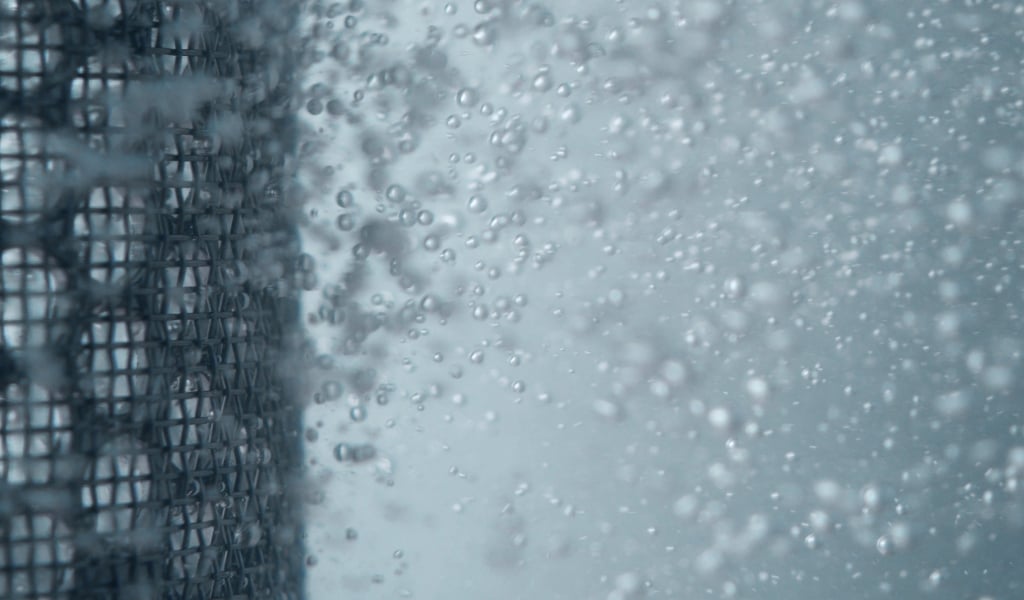The Impact of Filtration Design on Desalination
Desalination is a critical solution for addressing global water scarcity, but its implementation often involves both high capital and operational costs. Operational costs in water treatment are largely driven by energy consumption and frequent maintenance, especially when filtration systems fail to operate efficiently.
Unfortunately, filtration is frequently treated as secondary consideration, despite its direct influence on the performance and longevity of desalination systems.
Optimizing filtration design, particularly through the use of advanced filter media, can significantly reduce these costs. Among the available options, woven wire mesh filters stand out for their ability to deliver high flow rates with minimal pressure loss, superior backwashability, and long-term durability. These characteristics make them ideal for pretreatment stages in desalination, where consistent and efficient filtration is essential.
At W.S. Tyler, we believe in creating cleaner and safer filtration solutions backed by over 150 years of engineering excellence. Our woven wire mesh filters are designed to meet the rigorous demands of pre-filtration for desalination while promoting sustainability, reducing waste, and improving system reliability. We’re committed to helping engineers and plant operators achieve long-term cost savings without compromising performance.
This article will explore how filtration design impacts desalination system efficiency, compare woven wire mesh to traditional filter media in terms of operational costs, and outline strategies for integrating mesh filters into desalination systems for optimal return on investment. By the end, you’ll understand why woven wire mesh is not just a viable option but a strategic advantage in modern desalination.
The Role of Filtration in Desalination System Efficiency
Desalination systems rely on a series of complex processes to convert saline water into potable water. Among the most widely adopted methods are reverse osmosis (RO), multistage flash evaporation (MSF), multistage distillation (MED), and mechanical vapor compression (MVC).
While thermal processes like MSF, MED, and MVC may not require extensive pretreatment, membrane-based systems such as RO are highly dependent on effective filtration to prevent fouling, maintain energy efficiency, and ensure long-term reliability. As RO continues to dominate modern desalination, filtration design has become a critical factor in operational performance and cost control.
Seawater presents a uniquely harsh environment for filtration systems. High salt concentrations, suspended solids, biological contaminants, and fluctuating feedwater conditions place significant mechanical and chemical stress on filter elements.
These challenges are compounded by the need for consistent performance over long operational cycles. Traditional filtration media often fall short under these conditions, leading to frequent replacements, increased maintenance, and compromised system reliability.
The effectiveness of a filtration system is governed by several design parameters, including pore size distribution, flow rate, pressure drop, and material compatibility. Systems that fail to optimize these variables often experience reduced throughput and higher operational costs. For example, filters with inconsistent pore structure may allow fine particles to pass through, increasing the load on downstream membranes which are extremely costly to replace, making efficient pre-filtration essential.
Similarly, materials that degrade under saline conditions can introduce contaminants and require premature replacement.
To meet the demands of modern desalination, filtration systems must be engineered for both performance and durability. This includes selecting materials that resist corrosion, designing structures that withstand mechanical loads, and implementing configurations that support high dirt-holding capacity without sacrificing flow uniformity.
These requirements have led to the development of advanced solutions like sintered mesh laminates, which are a technically and economically superior alternative to conventional media.
How Filter Media Selection Influences Operational Costs
Traditional filtration media used in desalination pretreatment, such as sand, cartridge, and depth filters, have long been the industry standard due to their availability and low upfront cost. However, these systems often fall short in high-demand environments.
Sand filters require frequent backwashing and struggle with fine particulate removal. Cartridge filters offer solid precision but are single-use, leading to high replacement costs and waste. Depth filters, while effective in layered filtration, are prone to clogging and difficult to clean, resulting in increased maintenance and downtime.
Woven wire mesh filters, especially when engineered into multilayer filter elements, offer a more refined and sustainable solution. Their uniform pore structure enables precise particle retention, which is critical for protecting expensive downstream RO membranes.
Unlike disposable filters, woven wire mesh can be cleaned and reused multiple times without compromising performance. This reusability not only reduces material waste but also lowers long-term operational costs. Additionally, the open area and permeability of mesh structures support high flow rates with minimal pressure drop, improving system efficiency.
Looking to upgrade your water filtration system? Learn why woven wire mesh is the best choice in our article below:
One of the key differentiators of advanced woven wire mesh, especially sintered mesh laminates, is their mechanical and chemical resilience. These laminates are composed of multiple mesh layers that are metallurgically bonded, resulting in approximately 25% higher burst pressure resistance compared to non-sintered filter elements and eliminating the need for additional support structures. When manufactured using seawater-resistant alloys like Avesta 254 SMO, the filters achieve exceptional corrosion resistance with a PREN value of 43.
This makes them ideal for long-term use in saline environments, where conventional materials often degrade rapidly.
From an economic standpoint, woven wire mesh filters offer a compelling value proposition. Their durability and cleanability reduce replacement frequency and labor costs, while their structural integrity enhances operational safety. The combination of surface and depth filtration in sintered laminates allows for high dirt-holding capacity and uniform flow, reducing the need for secondary filtration stages.
For desalination plant operators, these benefits translate into lower lifecycle costs, improved system reliability, and a more sustainable filtration strategy, all of which support long-term ROI.
Design Optimization Strategies for Cost-Effective Desalination
Designing a desalination system that balances performance with cost-efficiency requires careful consideration of every component. Pretreatment systems must be engineered to handle high volumes of saline water while maintaining consistent output quality.
Woven wire mesh filters, when integrated early in the design phase, offer a scalable solution that supports high throughput, minimizes pressure loss, and reduces the burden on downstream processes like reverse osmosis.
One of the key advantages of woven wire mesh is its adaptability. Mesh filters can be customized by adjusting mesh count, wire diameter, and layering configurations to meet specific feedwater conditions and system requirements.
In desalination applications, this means tailoring the filtration precision to reduce SDI and turbidity levels, which directly impacts membrane longevity and energy efficiency. The ability to engineer mesh laminates like POROSTAR with process-specific layers such as the filter, protective, and support layers allows for optimized performance across a wide range of operating conditions.

Material selection plays a critical role in the long-term viability of filtration systems exposed to seawater. Alloys like Avesta 254 SMO, with the ability to be used in sintered mesh laminates, offer exceptional resistance to corrosion, mechanical stress, and chloride-induced degradation. These properties are essential for maintaining filter integrity in high-salinity environments.
The sintering process further enhances mechanical stability, eliminating the need for additional support structures and enabling reliable, series-ready production of seawater-resistant filter elements.
Integrating woven wire mesh into desalination system design yields measurable operational and financial benefits. The durability and cleanability of mesh filters reduce maintenance frequency and labor costs, while their high dirt-holding capacity and uniform flow characteristics improve overall system reliability.
By minimizing the need for secondary filtration stages and reducing downtime, plant operators can achieve a lower cost of ownership and a faster return on investment. These advantages position woven wire mesh as a strategic asset in the design of modern, cost-effective desalination infrastructure.
Reducing Desalination Costs Through Smarter Filtration Design
Filtration design plays a pivotal role in the performance and cost-efficiency of desalination systems. While reverse osmosis (RO) and ultrafiltration (UF) processes rely heavily on effective pretreatment, including mechanical filtration, thermal methods like MSF, MED, and MVC do not necessarily require it, although they are generally less efficient. As membrane technologies continue to dominate modern desalination, the role of filtration in ensuring operational success becomes increasingly critical.
Traditional filter media often falls short under the harsh conditions of seawater treatment, leading to increased maintenance, higher energy consumption, and reduced system uptime.
Woven wire mesh, particularly in the form of sintered mesh laminates such as POROSTAR, offers a technologically advanced and economically sound alternative. With customizable configurations, high mechanical strength, and exceptional corrosion resistance, especially when manufactured from alloys like Avesta 254 SMO, these filters are engineered to thrive in saline environments. Their ability to combine surface and depth filtration in a single, reusable element makes them a strategic asset for any desalination operation.
At W.S. Tyler, our mission is to help create cleaner, safer, and more efficient industrial processes through precision-engineered woven wire mesh solutions. With over 150 years of experience, we understand the evolving demands of water treatment and are committed to delivering filtration technologies that meet the highest standards of performance and durability.
Interested in learning more about how woven wire mesh outperforms other filter media? Check out our article below:
About Dylan Polz
Dylan is a Content Writer with 2 years of experience in marketing and SEO. Passionate about learning and strengthening his writing skills, he is currently expanding his expertise in particle analysis and woven wire mesh technologies. With a strong belief in the power of information to drive positive change, his goal is to develop content that supports cleaner, safer solutions across all industries.



